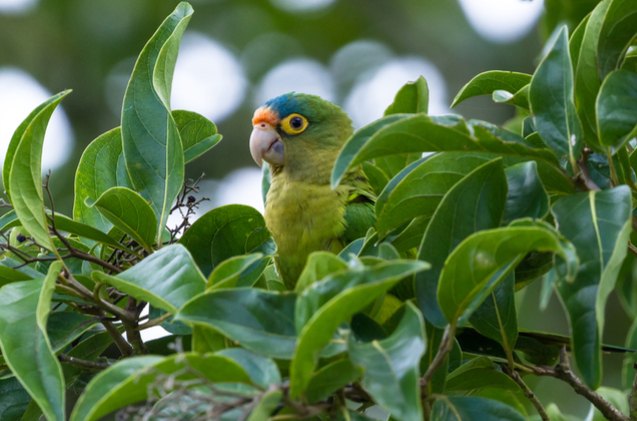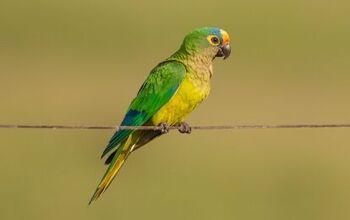Orange Fronted Conure


About Orange Fronted Conure
These feisty, small conures are loved all over the world and make a popular pet parrot. This is thanks to the friendly personality and happy-go-lucky attitude of the Orange Fronted Conure. These birds are also one of the better talkers among the Conure breeds. This makes them even more entertaining as they are often considered as the heart of every family and a spark that brings on all the fun. They can create a deep bond with their chosen family member and will never hesitate to show their excitement and love for them. Find out why Orange Fronted conures have become such a popular pet parrot!
Orange Fronted Conure is lively, fun, and a genuinely happy little parrot- no wonder they’re a popular pet!
Native Region/Natural Habitat
These are popular parrots of the Central American Pacific coastline, and their habitat spans a region that occupies great parts of Mexico and Costa Rica. They thrive in the regional light, open areas, arid lowlands and often in the tropical woodlands. Known as an “arboreal termitarium” breeder, they exhibit strange nesting behavior – as they lay their eggs in termite mounds that are found high up in the trees. At one time, their popularity being high, the capture for the pet trade has significantly decreased their populations in some places. But since then, the situation is much better and these birds once again have a healthy population in the wild.
Orange Fronted Conure, also known as the Half Moon Conure, is an important breed in the family of Aratinga Conures. As such, they retain many of the key features of this species and don’t differ a lot from their cousins other than their size – even though they are the smallest in the family. But still, with a few crucial details of their own, they are easily recognized. The adults reach an average length of 9 inches (24 centimeters) and weigh around 3 ounces (75 grams). A big part of their length is reserved for their slender, tapered tail feathers. There are not many differences between males and females, but a few distinct color changes will help you spot the females more easily.
Conures are not often noisy, and some of them can develop respectable talking skills. The Orange Fronted Conure is considered to be the quietest breed in this species. Naturally, this makes them a good choice for apartment owners. These parrots have moderately loud natural calls and will often chirrup and whistle in a cute way. While enjoying their food they have a tendency to murmur and chatter quietly to themselves. Some individuals can learn to talk and repeat quite a few words, all in a silly and endlessly entertaining way.
These lively-looking parrots display simple but effective color combinations, with impressive gradients of their plumage. They are somewhat similar to the Peach Fronted Conures. The body is mostly bright, tropical green and is lighter on the belly. Their cheeks are brownish green, while the upper head displays some unique details. These are the orange patch at the front of the head, and blue patch just behind it. The flight feathers on the wings are black and blue, and best seen in flight. Although simple, this color works best for a bird of this size, and their colorful details add a lovely and charming touch.
Be sure to take a close look – Orange Fronted Conures are often confused with their Peach Fronted cousins.
In the wild, these parrots enjoy a diet that consists of seeds, fruits, flowers. Some of their favorites are maize and bananas. A pre-made commercial seed mix for conures is the best choice for your pet’s diet at home. Add a daily dose of fresh fruit and an occasional vegetable and you’ll have a balanced diet and a happy pet. Hygiene is very important as well, but these conures are not very fond of bathing. To resolve this, you can find a middle ground – use the spraying technique and you can make sure your pet is clean and groomed.
Conures are known to be hardy and they adapt very quickly to all common conditions. Some of the threats include very low or very high temperatures, excessive draft, and damp unhygienic places. Also keep in mind that conures are very friendly, playful and sociable, and might depend on your attention and care. A neglected bird can become bored, then lonely, leading to feather plucking and self-abusive behavior. Make sure to always find enough time to play with your pet!
Conures are very playful and full of energy. Provide them with a lot of toys, perches, and swings.
These little silly conures are a real spark of fun, and with their energetic and friendly personality they quickly charm and make friends. They enjoy being handled and have a need for interaction with humans. Orange Fronted Conure also has no issues sharing space with other friendly parrots. Conures love toys and will always find new ways to play. Tricks and goofy behavior should not be a surprise. All of this means you can’t neglect your pet and plenty of interaction during the day is a must. In general, these loveable and affectionate parrots make great and entertaining friends. All the more reasons to love them!
Photo credit: Wollertz/Shutterstock; My Lit’l Eye/Shutterstock; Aushee/Shutterstock

A proud mama to seven dogs and ten cats, Angela spends her days writing for her fellow pet parents and pampering her furballs, all of whom are rescues. When she's not gushing over her adorable cats or playing with her dogs, she can be found curled up with a good fantasy book.
More by Angela Vuckovic

























